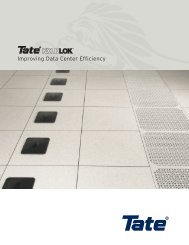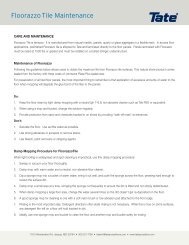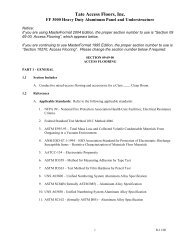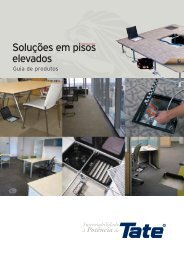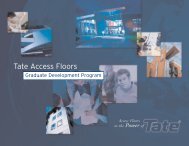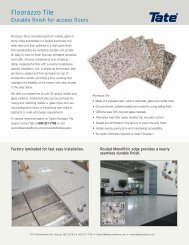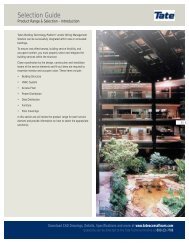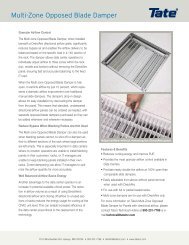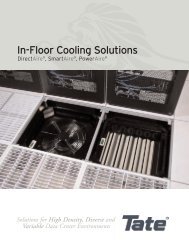CC1000 LFFH Freestanding - Tate Access Floors
CC1000 LFFH Freestanding - Tate Access Floors
CC1000 LFFH Freestanding - Tate Access Floors
Create successful ePaper yourself
Turn your PDF publications into a flip-book with our unique Google optimized e-Paper software.
<strong>Tate</strong> <strong>Access</strong> <strong>Floors</strong>, Inc.<br />
ConCore 1000 <strong>Access</strong> Floor Panel – Low FFH PosiLock Understructure<br />
<strong>Freestanding</strong> (Non-Cornerlock) System<br />
A. <strong>Access</strong> floor materials shall comply with the provisions outlined in FAR Subpart 25.2 – Buy<br />
American Act – Construction Materials.<br />
B. Floor panels shall be permanently marked with manufacturer’s name, product identification,<br />
manufacturing date and country-of-origin. Removable Product ID stickers are not acceptable.<br />
1.7 Performance Requirements<br />
Pedestals:<br />
A. Axial Load: Pedestal assembly shall provide a minimum 6000 lb. axial load without permanent<br />
deformation.<br />
B. Overturning Moment: Pedestal assembly shall provide an average overturning moment of 1000 inlbs.<br />
when glued to a clean, sound, uncoated concrete surface. ICBO number for the specific system or<br />
structural calculations shall be required attesting to the lateral stability of the system under seismic<br />
conditions.<br />
Floor Panels:<br />
A. Design Load: Panel supported on actual understructure (the system) shall be capable of supporting a<br />
safe working load or design load of 1000 lbs. This rating signifies that the system will withstand not<br />
only a concentrated load placed on a one square inch area at any location on the panel without<br />
yielding but also demonstrate the ability to withstand an overload capacity of two times its rating (i.e.<br />
a safety factor of 2). (For a detailed description of this important criteria, refer to the Design Load<br />
bulletin at www.tateaccessfloors.com and click on Resources/Technical Bulletins.)<br />
B. Safety Factor: Panel supported on actual understructure (the system) shall be capable of<br />
withstanding a minimum of (2) two times the design load anywhere on the panel without failure.<br />
Failure is defined as the point at which the system will no longer accept the load.<br />
C. Rolling Load: Panel and supporting understructure shall be able to withstand the following rolling<br />
loads at any location on the panel without developing a local and overall surface deformation greater<br />
than 0.040 inches. Note: wheel 1 and wheel 2 tests shall be performed on two separate panels.<br />
Wheel 1: Size: 3” dia x 1 13/16” wide Load: 800 lbs. Passes: 10<br />
Wheel 2: Size: 6” dia x 1 1/2” wide Load: 600 lbs. Passes: 10,000<br />
D. Impact Load: Panel and supporting understructure shall be capable of supporting an impact load of<br />
150 lbs. dropped from a height of 36 inches onto a one square inch area (using a round or square<br />
indentor) at any location on the panel.<br />
E. Panel Drop Test: Panel shall be capable of being dropped face up onto to a concrete slab from a<br />
height of 36”, after which it shall continue to meet all load performance requirements as previously<br />
defined.<br />
F. Panel Cutout: Panel with 8” diameter cutout shall be capable of withstanding an ultimate load<br />
without failure of 1500 lbs. anywhere on the panel.<br />
<strong>CC1000</strong><strong>LFFH</strong> PL / FS Page 2<br />
R11/08



